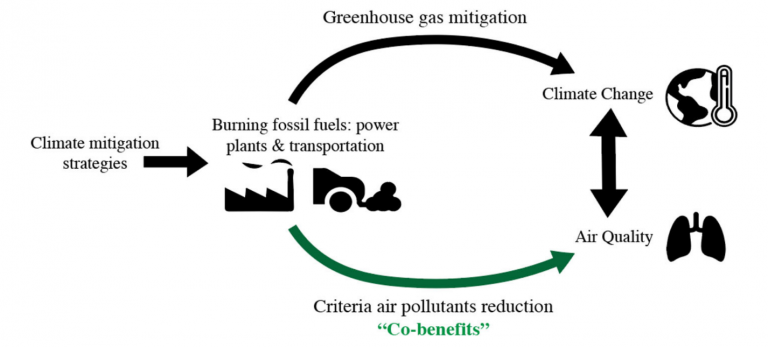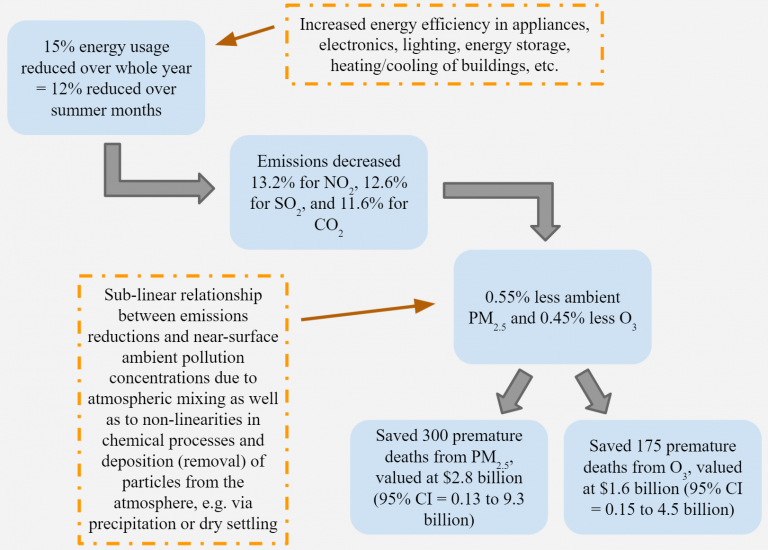
This trio of posts was inspired by the Health Effects Institute conference sessions on April 6th and April 20th, 2021.
***
In my last blog, I discussed how climate change could worsen air quality and exacerbate the health impacts of air pollution, alongside how fossil fuel combustion contributes to the global health burden in addition to causing climate change. Here, I’ll focus on how strategies for mitigating climate change could improve air quality and health. Below is an illustration of how decarbonization can have health “co-benefits”.

Gallagher and Holloway, Figure 1: A schematic of the co-benefits from climate mitigation strategies due to the relationships between climate change and air quality.
The 2020 review from which the above diagram was borrowed found that the air quality and health co-benefits of climate policies can offset the costs. For example, they estimated that the public health benefits of eliminating each ton of CO2 range between $50-250, which exceeds the cost of energy generation from renewable sources over these technologies’ lifetimes (referred to as the “levelized cost”). In case you’re curious, at the end of this post I’ve linked a recent article that provides a broader perspective on the total social cost of carbon.
This review also found that decarbonization strategies reduce air pollution disproportionately on days with more pollution. The importance of reducing spikes in pollution is widely recognized; the US NAAQS (introduced in my first blog) are in part based on peak pollution levels, averaged daily for PM2.5 and every 8 hours for ozone. Some research has shown that increased use of solar energy may be especially helpful on this front.
Another key point to keep in mind is that in contrast to slower-moving climatological changes as a result of reducing fossil fuel emissions, the benefits to air quality and health can occur almost immediately. This framing may help us to rationalize the upfront costs of decarbonization.
Of course, not all greenhouse gas (GHG) emissions reductions are equally health-protective. Intuitively, large emissions reductions in areas with more people will yield more health benefits in total. Also, reductions targeting PM2.5 sources yield the maximum health benefits. Specifically, regions with greater reliance on coal generation have the potential to gain more, in terms of both health and economic benefits, from renewable energy and climate policies. For example, though coal usage makes up only 48.5% of US energy generation, it generates 98.7% of SO2, which contributes heavily to PM2.5 formation, in addition to 80.4% of NOx and 67.6% of CO2.
A 2019 study investigated the impacts of increased energy efficiency on US air quality and health. Due to computational constraints, they only modeled the impacts over three summertime months. I created the following diagram to illustrate their findings.

These results translate into a health savings rate of $0.049/kWh ($0.031/kWh for PM2.5 and $0.018/kWh for O3), which for context is 45% of the US summertime average cost of electricity ($0.110/kWh).
A report published in July by the Clean Energy Futures team quantifies the US health impacts and economic impacts of achieving the Biden Administration’s clean electricity goal (80% by 2030* as the interim target for 100% by 2035) through a clean electricity standard. This study estimated $637 billion in climate benefits (calculated using a social cost of carbon of $50 / tCO2 in 2019 dollars), compared to $342 billion in costs, which include construction and operation of new energy infrastructure and retrofit energy facilities.
Employing models for air quality and health developed by the US EPA produced a co-benefit estimate of 317,500 premature deaths prevented between 2020-2050 from reduced exposure to fine particulate matter and ozone, resulting in $1.13 trillion in health savings. These models also showed air quality improvements in every state, for all racial and ethnic groups, with non-Hispanic Black people experiencing the largest reductions in pollution exposure. This last finding is especially significant in the context of current air inequality (described in my fourth blog).
All of the co-benefit estimates I have discussed in this post have been based on US data. These numbers would be much larger in absolute terms, and maybe also on the basis of kilowatt-hours or tons of CO2, accounting for the much higher rates of death and reduced quality of life from air pollution in many other countries around the world, as described in my first blog.
Taken together, these findings are pretty rosy. And while improved air quality and health are likely the largest “non-energy benefits” of decarbonization, there are many others including increased energy security, job creation, consumer comfort, and fire safety, as well as reduced water usage. I encourage you to keep the strength of this upside in mind as you read my next blog, in which I will explore some of the challenges associated with climate change mitigation strategies.
———
More on Ellen Considine here.
HPHR.org was designed by ComputerAlly.com.
Visit HPHR’s publisher, the Boston Congress of Public Health (BCPH).
Email communications@bcph.org for more information.

Click below to make a tax-deductible donation supporting the educational initiatives of the Boston Congress of Public Health, publisher of HPHR Journal.![]()